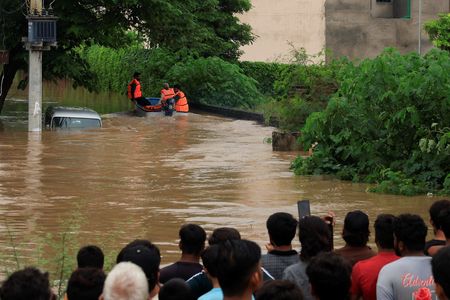LAHORE/SRINAGAR (Reuters) -Pakistan’s eastern towns of Chiniot and Hafizabad face a risk of catastrophic floods if an irrigation barrage crumbles on a major river upstream after heavy rains swelled it beyond capacity, officials warned on Thursday.
Nuclear-armed neighbours India and Pakistan are battling torrential monsoon rains that have unleashed flash floods, swelled rivers and filled dams, with 60 deaths this month in Indian Kashmir, and Pakistan’s toll at 805 since late June.
Any flooding blamed on India stands to inflame relations between the archfoes, embroiled in a tense stand-off since a brief conflict in May that was their worst fighting in decades.
The waters of the Chenab river in Pakistan’s sprawling province of Punjab threatened to burst through a 3,300-foot (1,000-m) concrete barrage at Qadirabad that regulates flows, siphoning them into a canal irrigation network.
“It is a crisis situation,” said a technical expert at the National Disaster Management Authority, adding that the collapse of the barrage could wash away the towns, home to more than 2.8 million.
“Under the constant supervision of experts and administration, the water level is receding, but it is still not beyond danger levels,” added the official, who sought anonymity as he was not authorised to speak to the media.
The threat comes as India’s release of excess water this week from its dams swelled river flows downstream in its neighbour’s breadbasket province of Punjab, home to half the population of 240 million.
Authorities said Pakistan evacuated more than 210,000 villagers near the rivers Ravi, Sutlej and Chenab that flow in from India, where heavy rain battered the northern region of Jammu, killing 60 people this month.
India routinely releases water from its dams when they get too full, with the excess flowing into Pakistan, accompanied by warnings from New Delhi, which calls them a humanitarian measure.
On Thursday, Pakistani officials said India passed on its third flood warning since Sunday, this time for the Sutlej, while the previous two concerned waters heading into Pakistan on the Ravi.
India’s water resources ministry did not immediately respond to a Reuters request for comment on the matter.
More than 900,000 cusec of water passed through the Qadirabad distribution structure on the Chenab river, or 100,000 cusec in excess of its capacity, the provincial disaster management authority said.
A cusec is a flow of volume equivalent to one cubic foot, or 28 cubic litres, every second.
On Wednesday, authorities blew up part of the riverbank to release some water before it reached the barrage.
Twelve people had been killed this week in Punjab, said Marriyum Aurangzeb, a senior minister in the provincial government.
“As one nation, we will face this challenge together,” said Aurangzeb, standing on the banks of the swollen Ravi. “There is no need to panic.”
The waters of Pakistan’s eastern rivers join those of northern rivers in Punjab in the giant Indus river, to flow through the province of Sindh before emptying into the sea.
On the other side of the border, Himalayan river levels began to recede after days of heavy rains that triggered landslides and flooding in both countries, with forecasters expecting downpours to subside from Thursday.
(Writing by Asif Shahzad; Editing by Clarence Fernandez)







